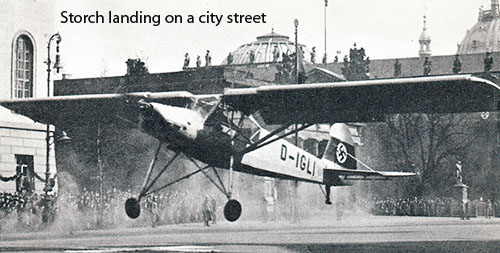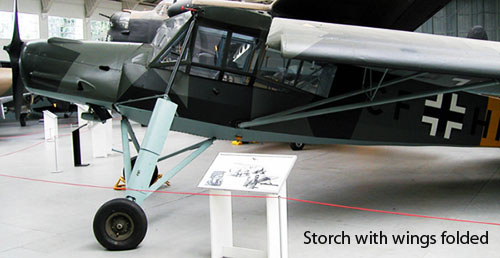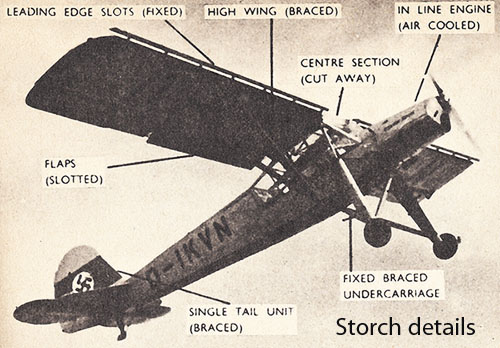Fieseler Storch
Today, a last dogfight. The University of Houston's College of Engineering presents this series about the machines that make our civilization run, and the people whose ingenuity created them.
The last aerial dogfight on the western front of WW-II was very odd. On April 12th, 1945, two Americans were scouting in a low-flying Piper liaison plane near Berlin. That was the popular Piper Cub in its military clothing. The Americans suddenly spotted another such plane, a German Fieseler Storch below them.
Neither plane was meant for combat, but the Americans opened their doors, leaned out, and began firing downward with their service revolvers. The Germans swerved and evaded. One wing touched the ground and they crashed. The Americans landed near by, captured the wounded Germans, and provided first aid.
That event seems anticlimactic -- even antediluvian -- in the most terrible war the world has ever suffered. Yet it was, in fact, a clash of titans. For the war, we modified our light planes (like the Piper Cub). The German army took a very different path: They issued an RFP for a troop support airplane and the Fieseler Company won the contract with its Storch. The famed German woman test pilot, Hannah Reitsch, tested it and the Storch went into production.

The Storch and the Piper Cub could hardly have been more different. We gave the wartime Cub the nickname Grasshopper since it was so small. It weighed a scant third of ton and was powered by a 65 horsepower engine. The Storch weighed a full ton (which was still light) and had an engine twice as powerful. It looked delicate and buoyant as a water lily. The name Storch (or stork in English) reflected its skinny shape and long-legged landing gear.

Both planes were meant to take off in a short distance and to fly at low speeds. The Storch did that remarkably well. It was equipped with flaps like the ones on a modern jet liner. And it had a slot along the leading edge of the wing to prevent stalling at low speeds. It could take off or land in a little over a hundred feet. Its wings folded back so it could be loaded on a truck. (You'll find a link to old film footage of Storchs in flight, below.)
Germany built almost three thousand Storchs. She used them on every front -- Russia, Africa, Finland, France. They scouted the ground and harassed foot soldiers. They carried generals, they carried stretchers. After Italy fell to the Allies in 1943, a Storch slipped Mussolini out -- only to have Hitler send him back with orders to set up a Fascist capital in Northern Italy.
So we flew our Cessna, Taylor, Luscomb, Aeronca, Stinson, and Piper airplanes -- almost forty thousand of them -- while Germany answered with its bigger, and perhaps better, Storch. When the British captured one, Field Marshall Montgomery commandeered it as his personal command airplane.
And so it came down to a last dogfight (if you can call it that) with a Piper Cub. The Storch became the only enemy airplane brought down with pistols during WW-II. But war is like that. In the end, it's primitive. We somehow ended the Second World War, back at the very beginning of the first one.
I'm John Lienhard at the University of Houston, where we're interested in the way inventive minds work.
J. L. Campbell, Fieseler Storch in Action. (color by Don Greer, Illustrations by David Gebhardt) (Carrollton, TX: Squadron/Signal Publications, Inc., 2005), No. 198. See also, A. Adcock, US Liaison Aircraft in Action. (color by Don Greer, Illustrations by David Gebhardt) (Carrollton, TX: Squadron/Signal Publications, Inc., 2005), No. 195.
Here is footage of a 1938 Fieseler Fi156 "Storch" taking off and landing. It also includes German newsreel footage of Mussolini's 'rescue." A propos of the latter, listener Bill Manuel writes about German named Willie Fiedler, who came to the US as a noted scientist after the war, and who described this historic event to him. Manuel says, "Willie was the test pilot sent to fly Mussolini down from the mountains. Willie told how Mussolini got into the airplane for the film but refused to take off in it. Willie flew down empty and Mussolini was driven down in a staff car."
Here is the Wikipedia article on the Storch.
Click here for more on the aerodynamics of STOL airplanes like the Storch.
In 2022, I was privileged to ride in Fieseler Storch. For a slide show of that event click here. Should you be interested, the last five slides provide detailed information about that particular Storch.
Images, top to bottom: US Air Force photo of a Grasshopper; Fieseler Storch photo courtesy of the National Aeronautics Council; JHL photo of a Storch at Great Britain's Duxford Air Museum; details of the Storch from a 1943 Infantry Journal, Aircraft Recognition.

